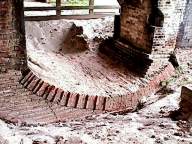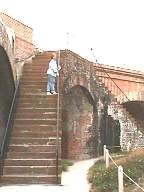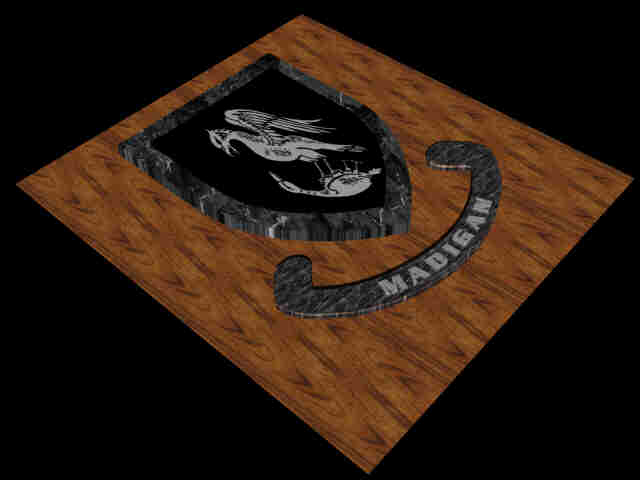The two walls facing the channel into
Pensacola Bay posed the greatest challenge. Longer than the other
fort walls, the channel fronts had more
brick and were designed
to mount 106 cannons. This would have been half of the Fort's
total armament. The solution to balancing this great weight was
reversed arches buried into the ground and designed to hold the
walls up, much as arches would hold a ceiling up. Although never
actually attacked, the guns
more
brick and were designed
to mount 106 cannons. This would have been half of the Fort's
total armament. The solution to balancing this great weight was
reversed arches buried into the ground and designed to hold the
walls up, much as arches would hold a ceiling up. Although never
actually attacked, the guns  which have never left American hands,
were fired on Confederate positions on the mainland in 1861. This
would be the only act of aggression taken by the Fort. As
technology advanced, old guns were replaced by bigger and better
guns. 1868 saw the arrival of the 15-inch Rodman cannon. Weighing
almost 25 tons, this gun fired a 15-inch ball weighing between
315 and 434 pounds to a range of 3 to 4 miles. It replaced six
smaller cannons mounted in 1860. This gun would in turn be
replaced in the 1890's by a still more powerful series of guns
mounted in concrete fortifications. Old gun emplacements, too
massive to modify, were abandoned for even larger, thicker
which have never left American hands,
were fired on Confederate positions on the mainland in 1861. This
would be the only act of aggression taken by the Fort. As
technology advanced, old guns were replaced by bigger and better
guns. 1868 saw the arrival of the 15-inch Rodman cannon. Weighing
almost 25 tons, this gun fired a 15-inch ball weighing between
315 and 434 pounds to a range of 3 to 4 miles. It replaced six
smaller cannons mounted in 1860. This gun would in turn be
replaced in the 1890's by a still more powerful series of guns
mounted in concrete fortifications. Old gun emplacements, too
massive to modify, were abandoned for even larger, thicker  fortifications. In 1898 the first of
the disappearing guns were added to the arsenal. When the
disappearing gun fired, the recoil from the firing lowered it
behind the steel-reinforced wall. From here it could be reloaded
without exposure to enemy fire. Lead counterweights
returned the weapon to the firing position above the wall.
Artillery batteries popped up here and there around the end of
the Island. By its end, several firing batteries housed 12 in.
disappearing rifles capable of firing a shell many miles out to
sea. All but one of the giant disappearing
fortifications. In 1898 the first of
the disappearing guns were added to the arsenal. When the
disappearing gun fired, the recoil from the firing lowered it
behind the steel-reinforced wall. From here it could be reloaded
without exposure to enemy fire. Lead counterweights
returned the weapon to the firing position above the wall.
Artillery batteries popped up here and there around the end of
the Island. By its end, several firing batteries housed 12 in.
disappearing rifles capable of firing a shell many miles out to
sea. All but one of the giant disappearing guns were sold. This
remaining
guns were sold. This
remaining  artifact is a real treasure. By the
time WW-II arrived the newly created 6-inch shield gun was
emplaced along the coastal side of the Fort. Like a turret,
4-inch thick cast steel wrapped around the 6-inch rifle to
protect the crew from machine-gun and light cannon fire. Each gun
and shield weighed 80 tons. Visibility from inside the shield was
difficult but was aided by radar. Then it was over. The atomic
bomb and guided missiles made coastal artillery ineffective and
it quickly became cost prohibitive. The Army sold the guns for
scrap and simply walked away. The massive concrete structures now
stand as silent sentries to a time gone by. Nature quickly
re-claimed the beaches and sand dunes immersing the old batteries
in a kind of eerie science fiction world, looking more
artifact is a real treasure. By the
time WW-II arrived the newly created 6-inch shield gun was
emplaced along the coastal side of the Fort. Like a turret,
4-inch thick cast steel wrapped around the 6-inch rifle to
protect the crew from machine-gun and light cannon fire. Each gun
and shield weighed 80 tons. Visibility from inside the shield was
difficult but was aided by radar. Then it was over. The atomic
bomb and guided missiles made coastal artillery ineffective and
it quickly became cost prohibitive. The Army sold the guns for
scrap and simply walked away. The massive concrete structures now
stand as silent sentries to a time gone by. Nature quickly
re-claimed the beaches and sand dunes immersing the old batteries
in a kind of eerie science fiction world, looking more  like the set for the next disaster
aftermath movie. The military gave the Fort to the State of
Florida for a park, who in turn gave it to the National Park
Service as part of the newly formed Gulf Island National
Seashore. The Park Service spent a half-million dollars
stabilizing and securing the Fort and outer batteries so that the
public could wander freely without undue danger of injury. Fort
Pickens is somewhat unique in National historical sites in that
it is not overly inundated with rules, regulations or
restrictions. Although there is a guided tour conducted by the
ever so knowledgeable Rangers, we were at our leisure to touch,
feel, and even Braille just about everything within reach. Sorry,
no climbing on the guns, but other than that, boy did I have fun!
like the set for the next disaster
aftermath movie. The military gave the Fort to the State of
Florida for a park, who in turn gave it to the National Park
Service as part of the newly formed Gulf Island National
Seashore. The Park Service spent a half-million dollars
stabilizing and securing the Fort and outer batteries so that the
public could wander freely without undue danger of injury. Fort
Pickens is somewhat unique in National historical sites in that
it is not overly inundated with rules, regulations or
restrictions. Although there is a guided tour conducted by the
ever so knowledgeable Rangers, we were at our leisure to touch,
feel, and even Braille just about everything within reach. Sorry,
no climbing on the guns, but other than that, boy did I have fun!
*** THE END ***

